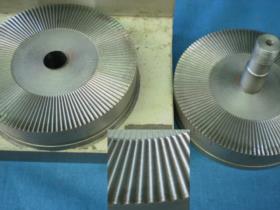
NavList:
A Community Devoted to the Preservation and Practice of Celestial Navigation and Other Methods of Traditional Wayfinding
From: Brad Morris
Date: 2017 Jan 16, 00:40 -0500
You are of course right about centring error, Brad, and you beat me to it with your exellent exposition. One way of minimising centring error is to make the centre first and then mount the instrument using that centre on whatever dividing device is used, e.g. a high quality rotary table, of which Jesse Ramsden's was the prototype. The device itself will have centring errors, and these would need to be very small.
Organ I think is being optomistic to think that he can make a Hirth device, generically called a face geared rotary table, out of plywood (but perhaps I misunderstood him). His teeth would be 2 mm from crest to crest and only 1.7 mm high, tapering as they proceed towards the centre. There is also the question of how to make 1440 divisions with reasonable accuracy. I have attached a photo of a 100mm diameter small face geared indexing table that I made about twenty years ago (yes, just for fun). The crests at the periphery are about 2.7 mm apart.and about 2.3 mm high. Face geared indexing tables are wonderfully accurate devices but making one is not for the faint hearted and of course they usually work with the table horizontal. If used vertically, the table has to be constained in some way.
It seems to me that the simplest dividing method for the home workshop is to start with an already-divided strip, a tape measure or even a piece of machine bandsaw blade, with the desired number of divisions, and then to make a centre bearing in a disc, mount it on that centre in the lathe and reduce its diameter until the strip will only just fit around the circumference. Provided the lathe bearings are in good condition, centring errors are minimised. There is no reason in principle why a vernier scale should not be used on the periphery rather than on the face and John Howard has dealt with how to construct one, though my preference would be for an extended one.
Frank Reed asked the question "Would a vernier sextant be easier to produce than a micrometer sextant?" Yes, without a doubt. The teeth on a sextant rack (or rather, the spaces between them) are not cut individually with a small formed rotary cutter, as it is too difficult to get a reasonable degree of dividing accuracy. Rather they are generated by a process called hobbing. My second photo shows a 14 tooth pinion being generated for a chronometer. The cutter is basically a screw thread with teeth cut in it and it is advanced into the gear blank while the two are geared together in the correct ratio for the number of teeth to be cut. To cut the rack on something the size of a sextant requires a big and complex machine, built with great attention to detail. There is a process called free-wheel hobbing, which can be used by the amateur to cut a large number of teeth, but the details are rather off-topic.
Most Computer Aided Drafting programs allow linear and circular dividing to be done, so producing a good quality scale of actual half degrees to a radius of, say, 150 mm with lines 0.1 thick is relatively easy. The difficult bit is to centre such a scale truly on the axis of rotation of the index arm. It could perhaps be done by attaching a magnifier with a graticule to the index arm and adjusting the scale until all excentricity is removed. I describe a similar process in the blog post here: https://sextantbook.com/
2009/03/ .Bill Morris
Pukenui
New Zealand
Attached File:
Attached File:








